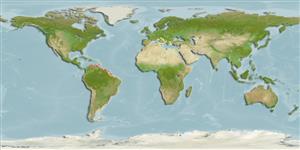Elasmobranchii (sharks and rays) >
Carcharhiniformes (Ground sharks) >
Sphyrnidae (Hammerhead, bonnethead, or scoophead sharks)
Etymology: Sphyrna: Greek, sphyra = hammer (Ref. 45335).
Environment / Climate / Range
Ecology
Marine; benthopelagic, usually ? - 12 m (Ref. 244). Subtropical, preferred ?; 46°N - 57°S, 73°W - 37°E (Ref. 244)
Southwest Atlantic: Venezuela to Argentina (Ref. 58839). Also Mediterranean Sea and Eastern Pacific (Ref. 7251).
Size / Weight / Age
Maturity: Lm ? range ? - ? cm
Max length : 134 cm TL male/unsexed; (Ref. 244); 148.0 cm TL (female)
A little-known inshore shark of the continental shelf, found down to at least 12 m depth. Feeds on small bony fishes, including sea catfish and grunts, but also newborn scalloped hammerheads, swimming crabs, squids, and shrimp. Viviparous with a yolk-sac placenta; number of young probably 6 to 9 per litter (Ref. 244).
Life cycle and mating behavior
Maturity | Reproduction | Spawning | Eggs | Fecundity | Larvae
Viviparous, with yolk-sac plazenta; number of young probably 6 - 9 per litter. Size at birth about 30 cm.
Compagno, L.J.V., 1984. FAO Species Catalogue. Vol. 4. Sharks of the world. An annotated and illustrated catalogue of shark species known to date. Part 2 - Carcharhiniformes. FAO Fish. Synop. 125(4/2):251-655. Rome: FAO. (Ref. 244)
IUCN Red List Status (Ref. 115185)
CITES (Ref. 94142)
Not Evaluated
Threat to humans
Harmless
Human uses
Fisheries: subsistence fisheries
More information
Age/SizeGrowthLength-weightLength-lengthLength-frequenciesMorphometricsMorphologyLarvaeLarval dynamicsRecruitmentAbundance
ReferencesAquacultureAquaculture profileStrainsGeneticsAllele frequenciesHeritabilityDiseasesProcessingMass conversion
Tools
Special reports
Download XML
Internet sources
Estimates of some properties based on models
Phylogenetic diversity index (Ref.
82805): PD
50 = 0.5029 [Uniqueness, from 0.5 = low to 2.0 = high].
Bayesian length-weight: a=0.00295 (0.00127 - 0.00686), b=3.17 (2.97 - 3.37), in cm Total Length, based on LWR estimates for this (Sub)family-body shape (Ref.
93245).
Trophic Level (Ref.
69278): 3.6 ±0.4 se; Based on diet studies.
Resilience (Ref.
69278): Very Low, minimum population doubling time more than 14 years (Fec=6).
Vulnerability (Ref.
59153): High vulnerability (59 of 100) .
